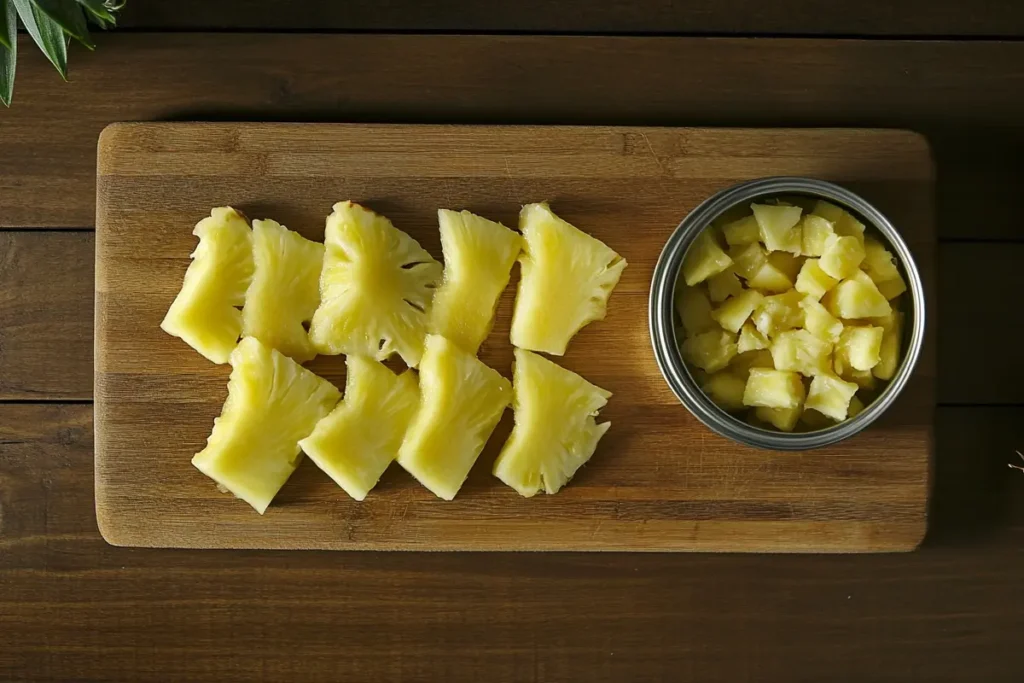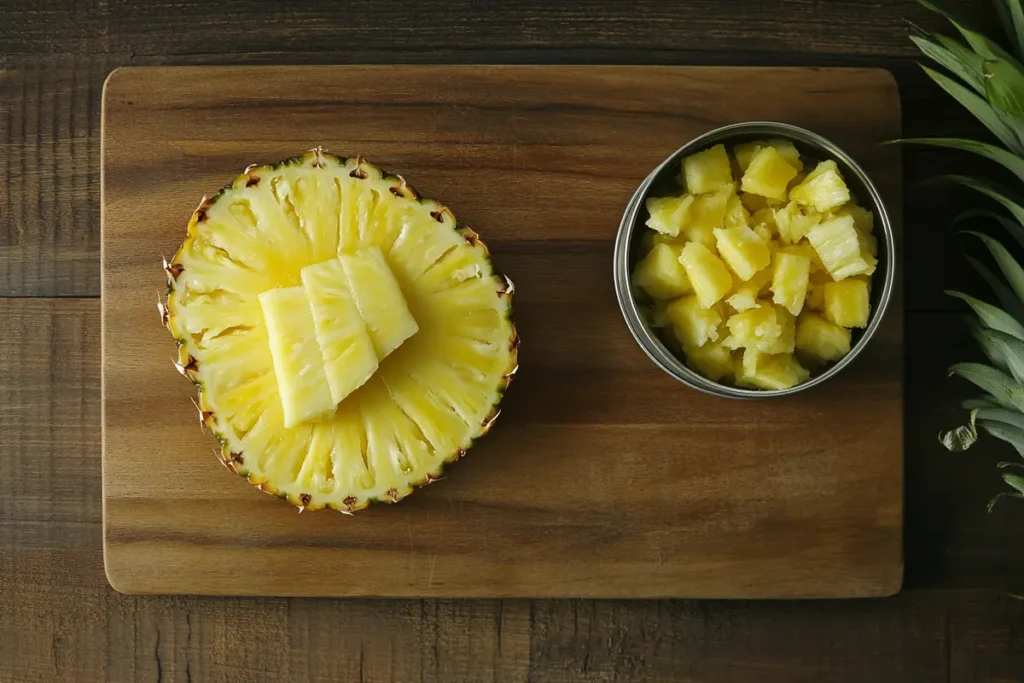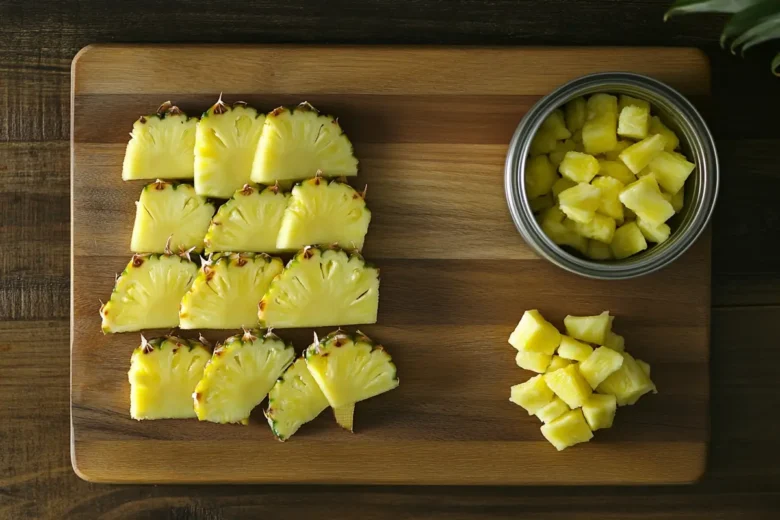Want to elevate your baking? Discover how to delicious substitute fresh pineapple for canned, adding a burst of natural flavor and texture to your treats.
Using fresh pineapple instead of canned is an easy way to make your baked goods taste amazing. It adds a bright flavor and a better texture. Let’s see how you can make this switch.
Why Choose Fresh Pineapple?
Fresh pineapple offers a different taste and texture compared to the canned version. The canned fruit is often packed in syrup, which can make it overly sweet and mushy. Fresh pineapple brings a tangier, brighter flavor that enhances your recipes. In addition, you avoid the added sugars and preservatives found in many canned products.
Flavor and Texture Differences
The primary differences between fresh and canned pineapple come down to flavor and feel. Fresh pineapple is naturally sweet with a tangy edge. This makes it a great addition to both sweet and savory baking. Canned pineapple is typically sweeter due to the syrup it’s stored in, and it tends to be softer. This can result in baked goods that are overly sweet and a bit mushy.
Health Benefits
Opting for fresh pineapple provides additional benefits. It is a source of vitamins, including vitamin C, and minerals. Fresh fruit is also naturally free from the additives often found in processed foods, offering a more wholesome choice. Using fresh pineapple can contribute to a more balanced diet with its natural nutrients.
How to Substitute Fresh Pineapple for Canned
Knowing how to substitute fresh fruit for canned is key to achieving the best results in your baking. Let’s look at the steps for successfully making this switch.
Preparation Tips for Fresh Pineapple
- Peeling and Slicing: Start by cutting off the top and bottom of the pineapple. Then, stand it upright and carefully slice off the skin from top to bottom. Next, you can cut the fruit into slices, chunks, or any shape needed for your recipe.
- Removing the Core: The core of the pineapple is tough, so you should remove it. You can do this by cutting around it or using a small cookie cutter to punch it out.
- Draining Excess Juice: If your recipe doesn’t call for extra liquid, gently pat the pineapple pieces dry with a paper towel to remove excess juice. This will prevent your baked goods from becoming too soggy.
Adjusting Recipe Quantities
You’ll often need to adjust the quantities when using fresh instead of canned. The following points can guide you:
- Weight vs. Volume: Canned pineapple is typically measured by volume, while fresh pineapple is often sold by weight. When substituting, try to use a similar weight of fresh pineapple as the volume of canned. For example, one cup of canned crushed pineapple will weigh differently compared to fresh pineapple pieces. So measure using a scale when possible for best results.
- Juice Content: Canned pineapple is usually packed in syrup or juice. Fresh pineapple has its natural juices but less added liquid. You may need to add a little extra liquid to your recipe, such as a bit of water or pineapple juice, if the batter or dough is too dry. Alternatively, you can drain canned pineapple to try and get closer to the liquid content of fresh pineapple
- Adjust Sweetness: Canned pineapple is often much sweeter than fresh. You might need to add a little more sugar to your recipe to achieve the desired level of sweetness. Start by adding a small amount and adjust to your taste preference.

Baking with Fresh Pineapple: Recipe Ideas
Now let’s explore ways you can use fresh pineapple in baking, offering both ideas and important tips.
Cakes and Muffins
Fresh pineapple works wonderfully in cakes and muffins. Its tangy sweetness adds a burst of flavor. This delicious fruit can complement a variety of flavors.
- Upside-Down Cakes: In an upside-down pineapple cake, use fresh pineapple rings. This creates a more attractive and flavorful version compared to the canned version. The natural sweetness of the fresh pineapple elevates this classic dessert.
- Muffins: Small chunks of fresh pineapple in muffins add both texture and taste. Consider adding a little shredded coconut for even better flavor.
- Spice Pairing: Try pairing fresh pineapple with spices like cinnamon or nutmeg to add depth to your baked goods. This will enhance the overall taste.
Bread and Scones
Adding fresh pineapple to bread and scones offers a delightful twist. This simple addition brings a touch of the tropics to your baking.
- Quick Breads: Try incorporating diced fresh pineapple into quick breads, such as banana or zucchini bread. This will add moisture and flavor. The result is a moister, more flavorful bread.
- Scones: Pineapple scones are a great way to start your day. The pieces of fresh pineapple add a juicy surprise in every bite.
- Texture Balance: If you find fresh pineapple makes your scones too moist, reduce the amount of other liquids slightly. This helps achieve the perfect texture.
Other Baked Goods
There are other creative ways to use fresh pineapple in baked desserts. These alternative options offer unique and tasty results.
- Cookies: Small pieces of pineapple in cookies add a tropical flavor. Combine with macadamia nuts or white chocolate for an exceptional treat.
- Pies: Try adding fresh pineapple to your fruit pies, or make a pineapple cream pie for something different. This enhances your pie’s flavor and texture.
- Bars: Add fresh pineapple to your favorite cookie bar or dessert bar recipes. The fruit’s natural sweetness will balance out rich flavors.

Troubleshooting: Common Baking Issues
Even with the best planning, baking issues can arise. Here’s how to solve common problems when using fresh pineapple instead of canned.
Adjusting for Moisture Levels
Fresh pineapple has high water content. Therefore, it can sometimes make your batter or dough too wet. You can reduce the chances of this issue in the following ways:
- Drain Excess Juice: Gently press the pineapple pieces using paper towels before adding them to your mix.
- Use Less Liquid: Try slightly reducing other liquids in your recipe to compensate for the added moisture.
- Adding Thickening Agents: If the batter is still too wet, add a little more flour or a thickening agent such as cornstarch.
Balancing Sweetness
Fresh pineapple is not as sweet as the canned version. Here is how to make sure your dessert has the perfect level of sweetness.
- Adjusting Sugar: Add a little more sugar to your recipe if you find it’s not sweet enough.
- Taste as you Go: Test your batter before baking, and adjust sweeteners as needed.
- Consider the Recipe: For some recipes, like a pineapple tart, a little extra sugar can enhance the overall taste when using fresh fruit.
Texture Consistency
Using fresh fruit can sometimes lead to a slightly different texture. How you cut the fruit, or how much of it you include, can change your result.
- Fruit Size: Ensure you are cutting your fruit into the right size. Some recipes may call for small pieces, while others might need larger pieces.
- Use Less Fruit: If you find your baked goods are too dense, use less pineapple next time.
- Mixing: Be sure to gently fold in the fruit. Over mixing can damage the texture.
Tips for Buying and Storing Fresh Pineapple
Here are some helpful tips when choosing, storing, and preparing fresh pineapple. Knowing these will ensure you have the best experience when using fresh fruit.
Selecting the Right Pineapple
- Check the Color: Look for a pineapple with a golden-yellow color. This suggests it is ripe. Avoid ones that are green or have brown spots.
- Smell the Base: A ripe pineapple should have a sweet smell at the base. This is a good indicator of its ripeness.
- Feel the Firmness: It should feel slightly firm. It should not feel too hard or too soft.
Storing Fresh Pineapple
- Room Temperature: A whole pineapple can be stored at room temperature for a few days.
- Refrigerator: Once cut, store pineapple pieces in an airtight container in the fridge. They will keep for several days.
- Freezing: If you want to store it for longer, you can freeze pineapple pieces in a single layer on a baking sheet before transferring them to a freezer-safe container.
- Use Within a Week: For the best quality and flavor, use cut pineapple within a week. This is especially important for baking.
The Appeal of Freshness
Using fresh pineapple in baking offers an elevated baking experience. It brings a burst of freshness and natural flavor. This choice will impress your guests.
Enhanced Flavors
Fresh pineapple has a more complex flavor profile than the canned version. It brings a nice blend of sweet and tangy taste that complements other ingredients. This flavor boost makes your baked goods more exciting.
Improved Texture
Fresh pineapple contributes a better texture to your baking. The pieces retain their shape better, adding a nice bite, unlike the sometimes mushy canned option. This makes a noticeable difference in the overall experience.
A Healthier Option
Choosing fresh pineapple gives you the advantage of avoiding added sugars and preservatives. This will result in a more wholesome treat, filled with natural nutrients. This aligns with a more conscious approach to cooking.
Conclusion
Using fresh pineapple instead of canned is an easy swap that will bring amazing results. It boosts the flavor, texture, and nutritional value of your baked goods. Experiment with different recipes. And you will taste the difference. With these tips, your baking is sure to be a success. Now, go grab a fresh pineapple and begin your baking adventure.

Frequently Asked Questions (FAQs)
How to substitute fresh pineapple for canned pineapple?
To substitute fresh pineapple for canned, start by preparing the fresh fruit by peeling, slicing, and removing the core. Match the weight of the fresh pineapple to the volume of the canned version. Reduce other liquids in your recipe to compensate for the added moisture, and add a little more sugar if needed for sweetness.
Can fresh pineapple be used in baking?
Yes, fresh pineapple can be used in baking. It adds a tangy, bright flavor and a better texture to your baked goods compared to canned pineapple. It’s great in cakes, muffins, breads, and other sweet treats.
Does canned pineapple work the same as fresh pineapple?
Canned pineapple is often sweeter and softer due to the syrup it’s stored in. Fresh pineapple has a tangier taste and firmer texture. You’ll need to make some adjustments to the recipe when using fresh fruit to balance moisture and sweetness levels.
How much canned pineapple equals one pineapple?
The yield of one fresh pineapple can vary depending on its size. However, a medium-sized fresh pineapple often equals about 2 to 3 cups of chopped pieces, which is similar to the amount found in two cans of 20-ounce canned pineapple.
You might also like:
Delicious Baked Branzino Recipe
Delicious Baked Branzino Recipe

